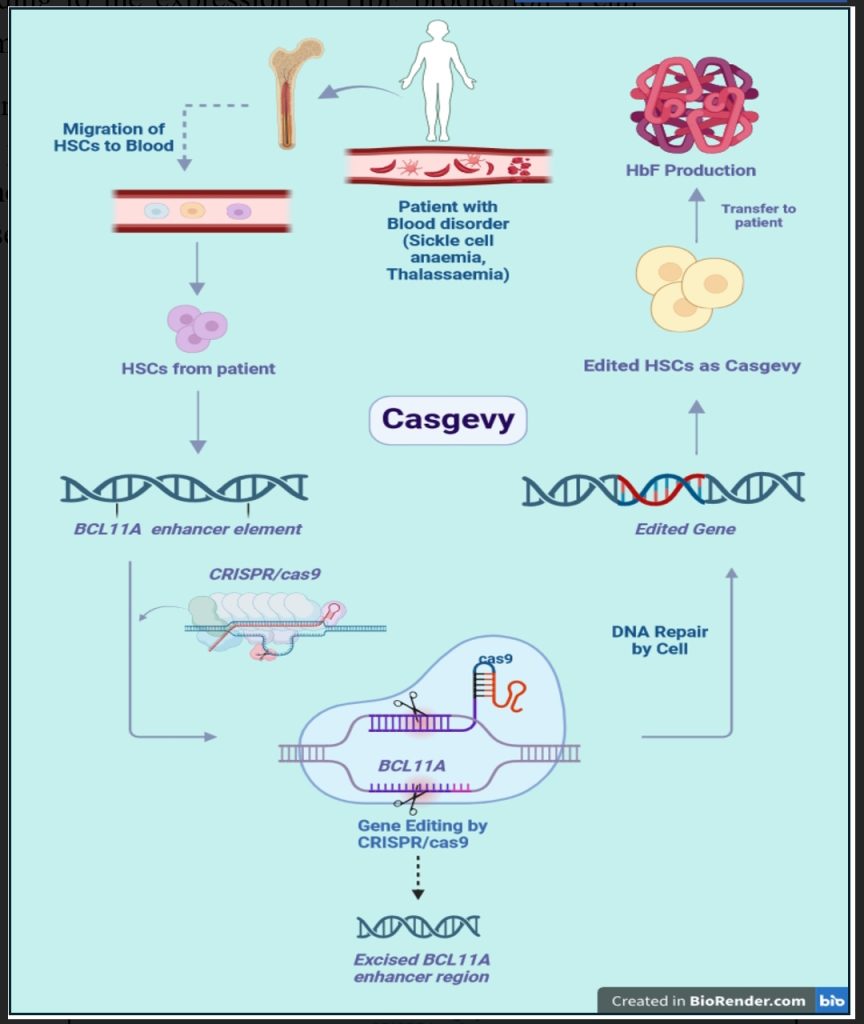Almost 20 million people around the world are living with sickle cell anemia, where roughly 60000 newborns are born with β-Thalassemia annually. The existing treatment for patients of these diseases majorly focuses on blood transfusion or bone marrow transplant at predetermined intervals. However, none of these are safe due to the high risk of graft rejection and infection. Finally, there’s a cure for these disorders. FDA and European Medicines Agency have authorized ‘Casgevy,’ a gene therapy-based orphan medicine (medicine of rare diseases) developed by Vertex, that uses CRISPR-Cas9 gene editing system to treat blood disorders such as β-Thalassemia and sickle cell disease in patients who are at least 12 years old. It was released on 9th February 2024.
Patients with β-Thalassemia have low red blood cell levels and need frequent blood transfusions, whereas sickle cell disease patients make red blood cells become rigid and sticky and change from disc-shaped to crescent-shaped (like a sickle). These cells block blood vessels and cause severe pain in different body parts. Casgevy can solve these problems using the CRISPR-Cas9 system.
How it works?
When we were inside our mother’s womb, we had human fetal hemoglobin (HbF) instead of adult-type Hb. Surprisingly, HbF doesn’t have any β chain. It contains α and γ chains. After birth, a gene BCL11A at chromosome 2 switches off HbF production and starts producing β chain for adult Hb. Pretty Exciting! Isn’t it?
β-Thalassemia and Sickle cell disease are caused by inherited mutation, which means parents, if carriers or diseased, may pass it to the next generations. This mutation forms a defective β chain of hemoglobin. So how about we turn off the switch of β chain production?
Well, that’s what exactly scientists thought.
Casgevy targets replacing adult Hb with defective β chain with HbF, leaving no room for developing β chain-associated disorders. To make this happen, Casgevy eliminates the gene BCL11A at chromosome 2 that regulates the β chain production through genetic engineering. The active substance of Casgevy is Genetically modified stem cells capable of developing normal blood cells mimicking the phenotype of HbF. The mechanism of action is as follows:
- Firstly, patients receive mobilization medicine that helps HSCs (Hematopoietic stem cells-stem cells that make blood cells) to migrate from bone marrow to blood. From blood, HSCs are collected to be genetically modified. It takes six months to complete the gene editing process. CRISPR/cas9 targets the erythroid-specific enhancer region of the BCL11A gene to reduce its production.
- The single guide RNA is complementary to the BRC11A gene enhancer region. It searches for the region and guides cas9. Cas9 is a molecular scissor that cuts the BRC11A gene enhancer region (Figure). When excised, the broken area is resynthesized by cellular repair machinery but not the same as previously. Thus, the BCL11A gene is downregulated in erythroid cells, leading to the expression of HbF production (Fetal hemoglobin)
- Gene-edited CD34+ HSCs are then transferred into the patient, where HbF dominates and normalizes the abnormal blood conditions. Depending on body weight, it is applied as a single dose infusion into the vein.

Success Rate:
In a study of β-Thalassemia patients aged 12 to 35, an impressive 39 out of 42 patients maintained hemoglobin levels above 9g/dL for at least 12 months without requiring blood transfusions. This promising outcome demonstrates the possibility of more effective disease management. Similarly, 28 of 29 patients with severe sickle cell disease in the same age group showed significant improvement, with no painful crises reported for at least a year. Surprisingly, none of these patients required hospitalization during this time, demonstrating the treatment’s efficacy in improving their overall quality of life.
Challenges to Overcome:
- unsuccessful establishment of neutrophils, a type of white blood cell crucial for fighting infections, following a stem cell or bone marrow transplant
- slower-than-expected recovery of platelet production
- Hypersensitivity Reactions or inappropriate immune responses
- unwanted DNA alteration risks due to off-target genome editing
- Higher Cost ($2.2 million per patient)
But undoubtedly, the invention of CASGEVY has brought sunshine to the treatment of β-Thalassemia and sickle cell disease. Further research should be conducted to diminish the risks.
References:
- https://www.casgevyhcp.com/sickle-cell-disease/mechanism-of-action
- https://www.ema.europa.eu/en/medicines/human/EPAR/casgevy
Author:
S.M. Yousuf Uddin
SUST, GEB (Content writer, Bio Daily)





Leave feedback about this